Josmar Marquez, from AveZona, has lead bird monitoring projects on Coche Island in Venezuela since 2018. In addition to data collection, his work involves mentoring young conservationists and promoting nature-friendly behavior changes in the local community of the island. Here, Josmar describes his most recent Snowy Plover monitoring season and some exciting firsts for shorebird monitoring in Venezuela. (More photo and Español debajo)
In Venezuela, thanks to the support of the BirdsCaribbean David S. Lee Fund, AveZona and the ARA MACAO Scientific Foundation have carried out population surveys of Snowy Plovers (Charadrius nivosus tenuirostris) on Coche Island. A large number of the birds have been recorded in the “Salina de San Pedro de Coche.” This has lead to an appreciation and increased value of the island as this species is threatened in the Caribbean region.
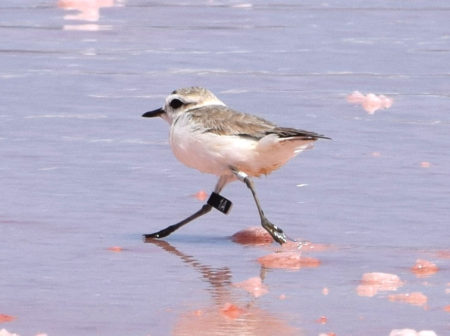
Our project formally began in 2019, and since then we have conducted monitoring visits monthly to the San Pedro de Coche salt pans. Before we stepped foot in the field, the first step was to receive permission from the Ministry of Ecosocialism (MINEC) for the relevant permits to be able to move forward with the project. Thankfully, we were successful.
During our monitoring visits, we record the following information: number and location of Snowy Plovers, their age (adults or juvenile), sex, and any reproductive activity. In addition to monitoring, we also have indivudally marked some of the birds. Our team marked the first Snowy Plover in Venezuela in September 2019. It may seem like a small feat but it represents a lot of work! The birds are marked with black flags and white codes (right leg) and metal rings (left leg). Marking the plovers will help us better understand the behavior of each individual and to determine their site fidelity. In addition, we can learn if there is any migratory movement across the Caribbean for our local population of Snowy Plovers. To date, we have tagged seven individuals.
In February and March, 2019, we were fortunate to count Snowy Plover nests and chicks in the San Pedro salina. Joining us for this activity were students from the local community at Napoleón Narváez Bolivarian High School. It was rewarding to share information about these precious birds with young people and they were amazed to learn that the salina is so important to the Snowy Plover and other bird species (for example, Least Terns also nest there).
How many plovers are there?
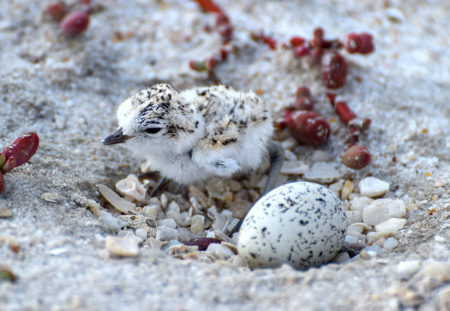
Currently, we are partnering with with Adrián Naveda-Rodríguez from the Department of Wildlife, Fisheries and Aquaculture at Mississippi State University, United States. Together, we are working on the detectability and abundance of the Snowy Plover in eastern Venezuela. The preliminary analyses are using samples from the non-reproductive season, from counts made at 12 points in the San Pedro de Coche salina.
We modeled the relationship between detection probability and air temperature, time of the day, and distance to salt. We included covariates for the number of feral dogs, horses and salt miners when modeling abundance. Detection probability was negatively affected by the distance to salt piles (0.49, 95% CI=0.49-0.5). Abundance was not associated with the presence or abundance of domestic animals nor salt mining activities. We estimated there were 96 (95% CI: 46-201) and 116 (95% CI=61-220) Snowy Plovers in February and December, respectively. We hope to present this information in more detail at the next NAOC and subsequently we plan to publish our results in a scientific journal.
Our group participated in the 22nd International BirdsCaribbean Conference in Guadeloupe in July 2019 and in the Western Hemisphere Shorebird Group Meeting in October 2019 in Panama. We were so excited to present the latest results from our research and the ways in which we involve the community in our projects.
A community effort
Our partnership with the community has continued beyond school field trips. Recently, we created a unique bird-inspired mural in the school of “La Uva” community which, of course, included depictions of the Snowy Plover and the Least Tern. It is truly a beautiful work!
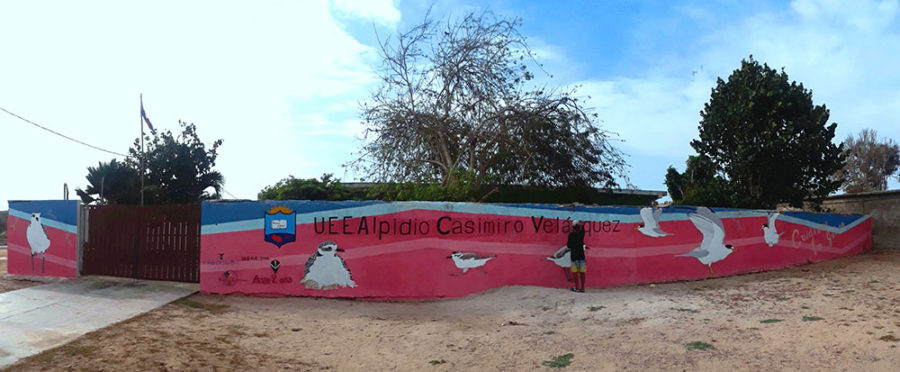
One of the reasons for working in this region is to promote the integration of communities that have historically been marginalized from science and conservation. In search of improving this situation, we are carrying out activities within this project that integrate and dignify the local community, and also give recognition to the worldview of the inhabitants of the biological diversity of their island.
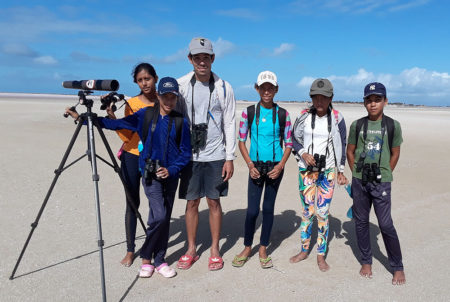
Since the beginning of this project, we understood that in order to protect the salina and other places on the island, it is necessary to work hand in hand with the locals. We are very grateful for the school district of Coche Island, which has allowed us to work with educational institutions. Also, we are especially fond of the Napoleon Narváez Lyceum High School 9th Grade class, and teachers from various educational institutions for their receptivity and commitment. There are many locals that have opened their doors and hearts to this project and our team: Antonio Ros, Daniel Serva, Oscar Riera, Jose Gonzalez, Jesus Escalona, JC Fernández Ordoñez.
Many obstacles can arise when executing a project of this magnitude in Venezuela, but thanks to the constant support of BirdsCaribbean (including the David S. Lee Fund for Conservation) we are achieving our objectives. It’s very important to carry out this project that will help us to better understand the population of the Snowy Plover in the islands of the Venezuelan Caribbean. For me, it is a beautiful, very peculiar bird with very interesting habits. Luckily, in Venezuela it still can be observed very frequently in some places. Being able to say that there is a reproductive colony on Coche Island, and that it remains to this day, is a light of hope in the face of the global ecological crisis.
Please enjoy these short videos showing our work with the community from our Ave Zona Facebook page!
Josmar marquez, de AveZona, ha liderado proyectos de monitoreo de aves en Isla Coche, Venezuela, desde el 2018. Además de la colecta de datos, Su trabajo consiste en asesorar a jóvenes conservacionistas y la promoción de cambios conductuales ambientalmente amigables en la comunidad local de la isla. Aquí, Josmar describe su más reciente temporada de monitoreo del Chorlito Nevado.
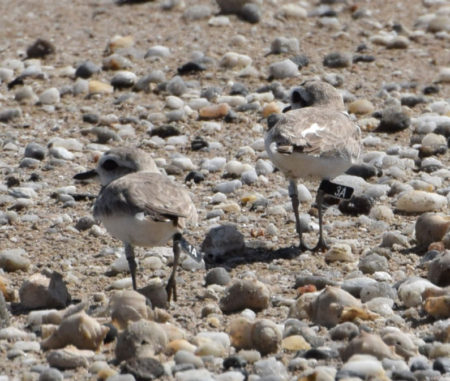
En Venezuela gracias al apoyo de la beca David Lee, de BirdsCaribean, AveZona y la Fundación Científica ARA MACAO realizan el proyecto de evaluación poblacional del Chorlito Nevado (Charadrius nivosus tenuirostris) en la isla de Coche. En “Salina de San Pedro de Coche” se ha registrado un alto número de aves, lo que ha llevado a un aumento en la apreciación del valor de la isla para la especie, que se encuentra amenazada en la región del Caribe.
El proyecto comenzó formalmente en 2019, y se están realizado salidas mensuales a la salina de San Pedro de Coche. Antes de dirigirnos al área, el primer paso fue recibir el permiso del Ministerio de Ecosocialismo (MINEC) para el estudio de campo. Afortunadamente, tuvimos éxito.
Durante las visitas de monitoreo, anotamos la siguiente información: cantidad de individuos y localidad, edad (adultos o juveniles), sexo, y actividad reproductiva del Chorlito Nevado. Además del monitoreo, también hemos marcado algunos individuos. Nuestro equipo marcó el primer Chorlito Nevado de Venezuela en septiembre de 2019. ¡Toda una hazaña! Se usaron banderas negras con códigos blancos (pata derecha) y anillos metálicos (pata izquierda). Marcar los individuos nos ayudará a entender mejor su comportamiento y determinar su fidelidad al sitio. Además, podríamos llegar a saber si existe algún movimiento migratorio entre esta población y el resto del Caribe. Hasta la fecha se han logrado marcar 7 ejemplares de Chorlito Nevado.
Durante los meses de Febrero y Marzo de 2019 logramos contar nidos y pichones de Failecito en la Salina de San Pedro. A esta actividad asistieron jóvenes del Liceo Bolivariano Napoleón Narváez. Fue muy gratificante compartir información sobre estas preciosas aves con los jóvenes y se sorprendieron al saber que la salina es tan importante para el Chorlito Nevado y otras especies de aves (por ejemplo, el Charrán Menor también anida allí).
¿Cuántos Chorlito Nevados Hay?
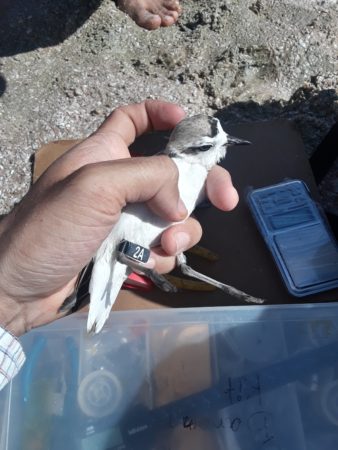
Actualmente, nos estamos asociando con Adrián Naveda-Rodríguez del Departamento de Vida Silvestre, Pesca y Acuicultura de la Universidad Estatal de Mississippi, Estados Unidos. Juntos, estamos trabajando en la detectabilidad y abundancia del chorlito nevado en el este de Venezuela. Los análisis preliminares están utilizando muestras de la temporada no reproductiva, de conteos realizados en 12 puntos en la salina de San Pedro de Coche.
Modelamos la relación entre la probabilidad de detección y la temperatura del aire, tiempo del día y la distancia a las pilas de sal. Incluimos covariables para la cantidad de perros salvajes, caballos y mineros de sal al modelar la abundancia. La probabilidad de detección se vio afectada negativamente por la distancia a las pilas de sal (0.49, IC 95% = 0.49-0.5). La abundancia no se asoció con la presencia o abundancia de animales domésticos ni actividades de extracción de sal. Estimamos que había 96 (95% IC: 46-201) y 116 (IC 95% = 61-220) Chorlito Nevados en febrero y diciembre, respectivamente. Esperamos poder presentar esta información en la próxima reunión del NAOC y publicarla posteriormente en alguna revista científica.
En agosto de 2019, nuestro grupo participó en la conferencia internacional de BirdsCaribbean en la isla de la Guadeloupe, y en noviembre de 2019 en la Reunión del Grupo de Aves Playeras del Hemisferio Occidental, en Panamá. Allí presentamos los avances de nuestra investigación, y las maneras en que involucramos a las comunidades en este proyecto.
Un Esfuerzo Comunitario
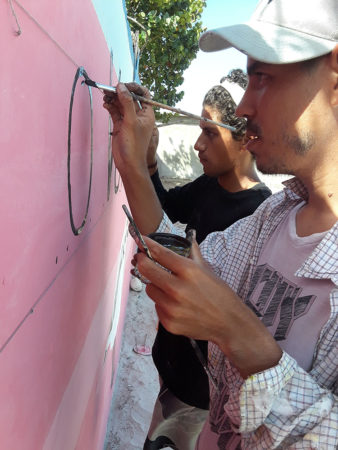
Nuestra asociación con la comunidad ha continuado más allá de las excursiones de la escuela. Recientemente, creamos un mural único inspirado en las aves en la escuela de la comunidad “La Uva” que, por supuesto, incluía representaciones del Chorlito Nevado y el Charrán Menor. ¡Es realmente un trabajo hermoso!
Una de las razones para trabajar en esta región es promover la integración de comunidades que históricamente han sido apartadas de la ciencia y la conservación. En busca de mejorar esta situación, estamos llevando a cabo actividades dentro de este proyecto que integran y dignifican a la comunidad local, y también reconocen la cosmovisión de los habitantes sobre la diversidad biológica de su isla.
Desde el comienzo de este proyecto, entendimos que para proteger la salina y otros lugares de la isla, es necesario trabajar de la mano con los lugareños. Estamos muy agradecidos con la dirección del municipio escolar Obteniendo todos los detalles perfectos en el mural.de Isla de Coche, que nos ha permitido trabajar con las instituciones educativas; así como con el Liceo Napoleón Narváez y los jóvenes de 9no grado, y docentes de varias instituciones educativas por su receptividad y compromiso. Hay muchos miembros de la comunidad que han abierto sus puertas y corazón a este proyecto y a nuestro equipo: Antonio Ros, Daniel Serva, Oscar Riera, Jose Gonzalez, Jesus Escalona, JC Fernández Ordoñez.
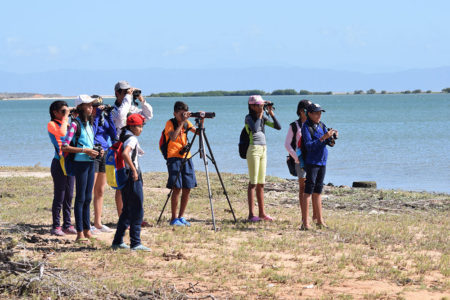
Pueden surgir muchos obstáculos al ejecutar un proyecto de esta magnitud en Venezuela, pero gracias al apoyo constante de BirdsCaribbean estamos logrando nuestros objetivos. Es muy importante llevar a cabo este proyecto que nos ayudará a comprender mejor la población del chorlito nevado en las islas del Caribe venezolano. Para mí, es un pájaro hermoso, muy peculiar con hábitos muy interesantes. Afortunadamente, en Venezuela todavía se puede observar con mucha frecuencia en algunos lugares. Poder decir que hay una colonia reproductiva en la Isla de Coche y que permanece hasta el día de hoy es una luz de esperanza frente a la crisis ecológica mundial.

We can’t thank you enough, Birds Caribbean David S. Lee Fund for Conservation for helping this project. The support provided by this Fund in the Caribbean region is extremely important, it has been very timely and very helpful for us in Venezuela.
Congratulations on the work.
I work with Red Knots monitoring in Lagoa do Peixe south of Brazil and I intend to work with the local community on actions like the ones you developed.
Good luck.
You are very welcome Josmar!!! We are excited about your work and all that you are able to accomplish for shorebirds and Snowy Plovers with your comprehensive project – keep up the great work! Lisa Sorenson, Executive Director, BirdsCaribbean
It’s really great to hear that you work with Red Knots – such an important species that needs conservation! Please keep us posted on your project, and all the best for much success! – Lisa Sorenson (BirdsCaribbean Executive Director)